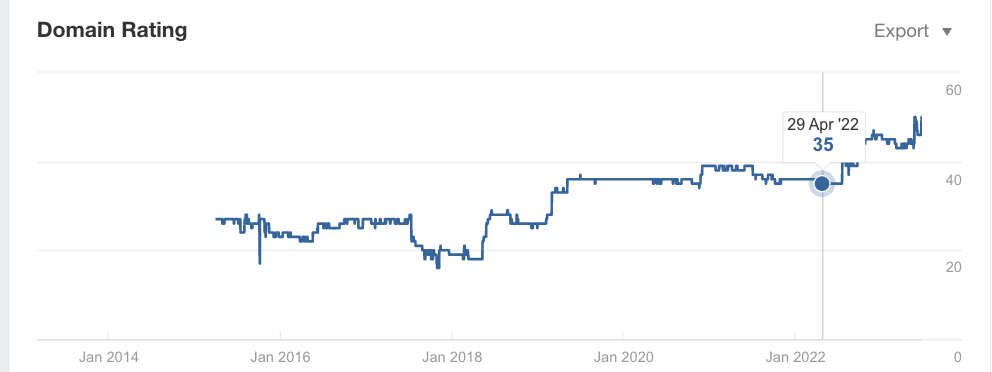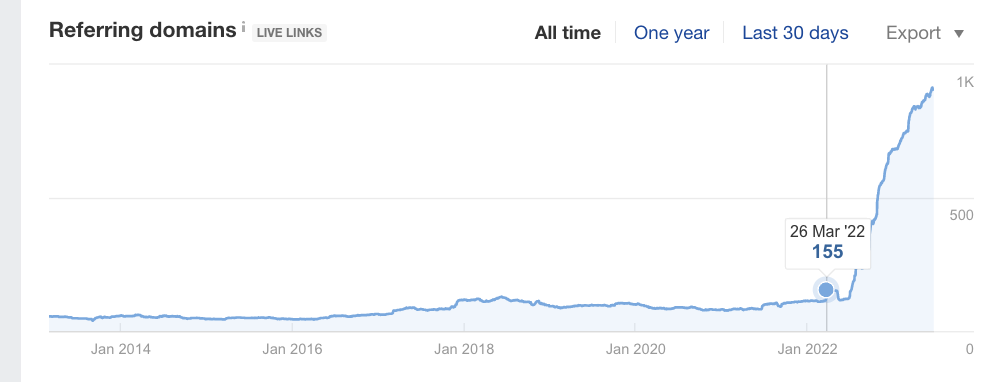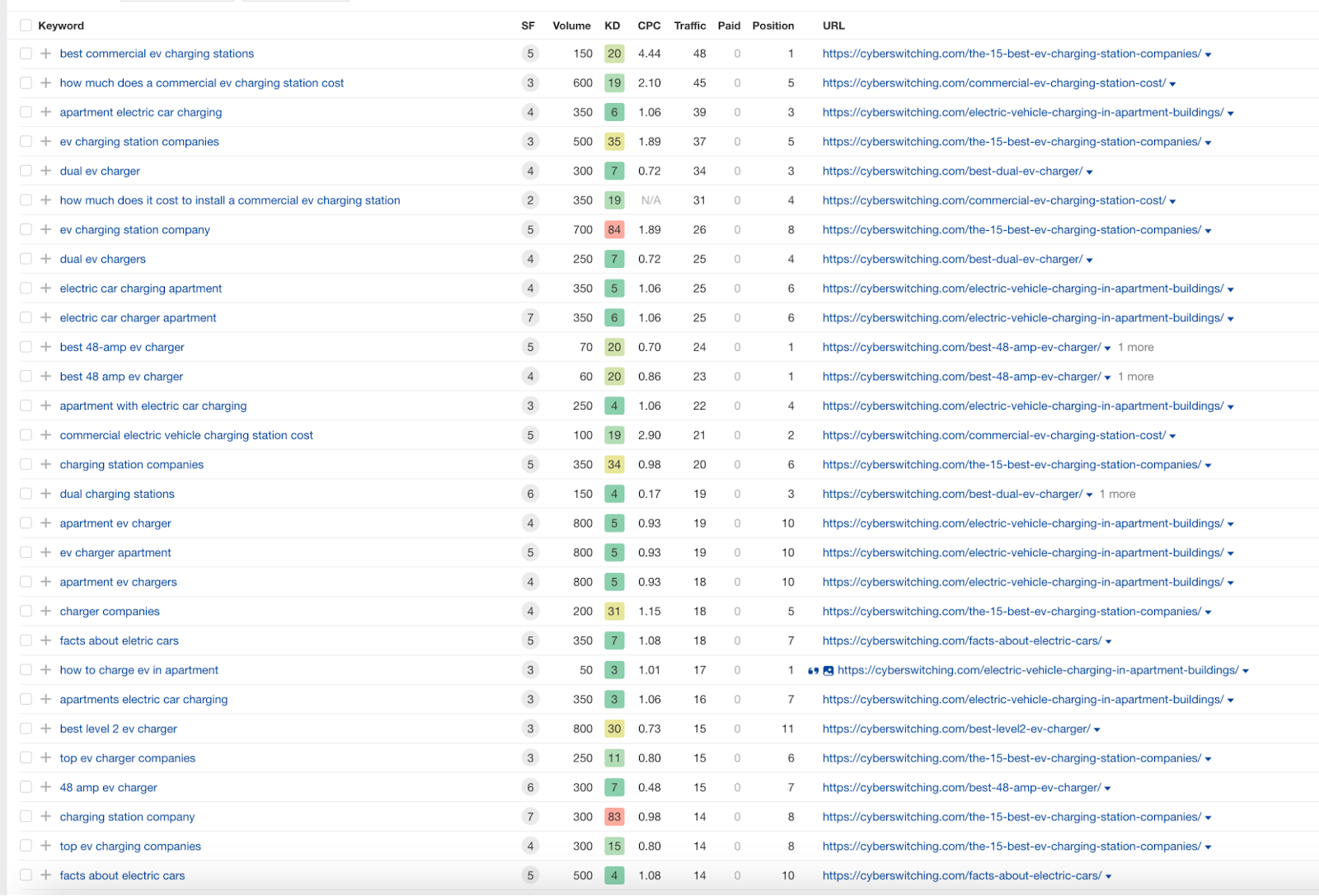Generative AI has rocked the tech world, and every company is now considering if there is a way for them to leverage this technology. Since the introduction of ChatGPT, the tech industry has been buzzing with its potential impact, especially in content-heavy industries like marketing and advertising.
We used OpenAI to improve our SEO ranking on Google, which had positive results across the board. In less than a year, our site’s organic traffic went from nothing to approximately 3,500 visitors a month, the domain rating increased by over 40%, and the backlinks increased by over 500%.
We increased our organic traffic

Our site’s organic traffic saw a sharp increase after we started using OpenAI in March 2022. Image Credits: Cyber Switching
Our domain rating saw an increase of over 40%

Our domain rating saw an increase of over 40%. Image Credits: Cyber Switching
Given the SEO ranking improvement, our domain rating saw an increase of over 40%.
And we boosted backlinks by more than 500%

We used OpenAI to boost backlinks by more than 500%. Image Credits: Cyber Switching
All screenshots are from June 23, 2023.
Through keyword-optimized blog posts generated by ChatGPT, we were able to really hone in on target keywords that rank high for many of the target phrases, like “best 48 amp ev charger.” It also allowed us to join the conversation with many other blogs by increasing our keywords from 300 to over 7,000, which led our website clicks to jump from 100 per month to 4,000.
Here are a few ways any business can utilize generative AI technology to optimize their marketing strategy.
Train the AI system to find optimal keywords
Before asking ChatGPT to generate an entire strategy document from scratch, you need to begin with the basics. Start by identifying your goals and let that inform your process. Ask ChatGPT for the most common keywords related to your industry, then drill down farther from there by asking for alternate phrases and options.
We started with the question:
- What are the most common SEO keywords related to the EV charging industry?
It provided a list of 20 phrases such as “electric vehicle charger,” “EV charging station,” “level 2 charger,” and “home EV chargers.” The AI is not perfect: ChatGPT recommended keywords associated with home EV chargers when our SEO needs to focus on commercial EV chargers.
Once you settle on the relevant keywords, ask ChatGPT to organize the list into commercial, transactional, and informational words. These categories will be crucial for the smart prompts used later on to create targeted content for various areas of your website.
You’ll also need to do the same keyword search in order to build OpenAI’s knowledge of your company. Give the AI tool additional information, like the boilerplate from your last press release, the “About” section on your website, your company’s social media profiles, or any other assets you already have.
There is no need to reinvent the wheel, so use content you’ve already worked on to help generate better keywords, recommendations, and ultimately, your marketing strategy.
As we fed the AI system more information, the results formulated improved and the recommendations got better. Remember that AI is about training the data, so as you progress, the answers shared will become more and more accurate. The more data you provide the AI tool, the better it will understand your company and industry.
Use targeted categories to create marketing content
After using AI to highlight target keywords within your website as well as your industry, you can develop an SEO strategy guaranteed to help you secure a top spot in search results.
One of ChatGPT’s best use cases is for content generation like blog ideas, titles, and website copywriting. Make sure to do this in the same ChatGPT thread you started with, as this is where you have trained the AI system. Here is a prompt you can use to get this going:
- Given all of the above information, create a marketing strategy that includes a six-month plan, keywords to target, several blog topics, and best practices.
While this example is quite broad, you can hone in even further on key areas by using the targeted SEO word categories created in the above section. For example:
- Come up with 10 informational blog post ideas to boost SEO ranking of the informational keywords.
We used AI to generate 100+ blog titles that were then used to further formulate full blogs. You can, of course, adjust the content shared by OpenAI, but use the content generated as a starting point to work from. This enabled us to generate blog posts at a much faster rate and optimize the target keywords where necessary.
As you can see from the data below, each of the target keywords has a URL link in the form of a blog post to drive traffic and boost its SEO rating.

A list of AI-generated target keywords. Image Credits: Cyber Switching
This tool is especially useful when drafting metadata descriptions for products. Share with ChatGPT all the information you have on the specific product, like info sheets, facts, or maybe a previously written website description. Then ask it the following request:
- Write a metadata description (160 characters) for the <name of product> and incorporate the commercial SEO keywords previously shared.
Generating content using AI is a starting point. You’ll still need to assess its quality, determine where best it fits and modify it as needed. But if you follow this process, you’ll have a working strategy that can push your marketing goals forward.
Smarter prompts = better content
You’ll quickly discover the importance of phrasing prompts accordingly. Consider the difference between these two prompts:
- Write me a post about the best wineries in California.
- Write me a blog post talking about the importance of family-owned wineries in California, and the unique experience customers get when they choose small businesses.
The more context and style you give ChatGPT, the more likely you are to get something that aligns with your company’s voice.
Each goal will instigate a different prompt, so consider the audience that will be reading it and where it will be shared. Founder and chief strategist at Colony Spark, Bill Murphy, shared a list of more than 190 ChatGPT prompts for marketers separated into categories based on end goal.
If your goal is to boost SEO ranking, consider prompts like:
- Generate # unique title tags, of a maximum of 60 characters, for the following text. They should be descriptive and include the term <keyword> in them.
- Generate a meta description of a maximum of <155 characters>, for a webpage about <topic of your choice>.
- Rephrase the following email while keeping its meaning, to make it sound fun but still professional.
The AI doesn’t have intuition, so you will quite literally have to spell it out: How many characters do you want the content to be? What’s the best length for a metadata description, or what tone of voice is most commonly read in a blog post? While these prompts from Airtable share inspiration on how you can leverage this tool, the possibilities are endless if you know how to engineer a strong prompt.
Use AI to audit your site and tackle ongoing SEO issues
Quality lead generation comes from having a strong search-optimized site. If you already have a website up and running but rewriting its copy isn’t an option, start by understanding what SEO issues it has.
Asking OpenAI to analyze your business’ website will identify basic issues like page speed and mobile optimization. Some prompt examples to help you get started are:
- Run an audit of the following website for SEO issues.
- What SEO issues does this site have?
Information that may come up could include missing title tags, incomplete meta descriptions, improper usage of header tags, missing internal links, viewing not optimized for mobile usage, or slow page load speed. Each factor weighs in on where the page will rank on a search engine. From there, you can circle back to the previous section and find a smart prompt to tackle the issues head-on.
There is other marketing research you shouldn’t look past as well. If your company is highly technical or not as well known, these are likely barriers for would-be customers. Use ChatGPT to troubleshoot common problems with your product or industry so you know potential customers’ questions. Addressing this now means your marketing is tailored, specific, and more likely to convert users. You can also use this to help create an FAQ section on your website. Prompt examples include:
- What are common questions people have about my product?
- What are the most common complaints about my industry?
Embrace your newest team member tool
Generative AI isn’t replacing anyone, but it is a powerful tool at your disposal to allow your team to spend more time on the things that matter. In order to make it work in your company, you need to assess your infrastructure to see where AI can fill in gaps.
Ask yourself, Who is the best person to work with AI? Who’s in charge of editing and approving generated text? Who’s monitoring your SEO rankings once it’s implemented?
Look online to find training and courses available to your team, and spend time on Twitter to see how others are using the program too. You can also use other AI programs to supplement your work, like Scalenut, Jasper, FullStory, PlayHT, and Growth Channel. These steps will make the transition that much smoother and ensure you’re optimizing your AI-generated marketing strategy to its fullest potential.
